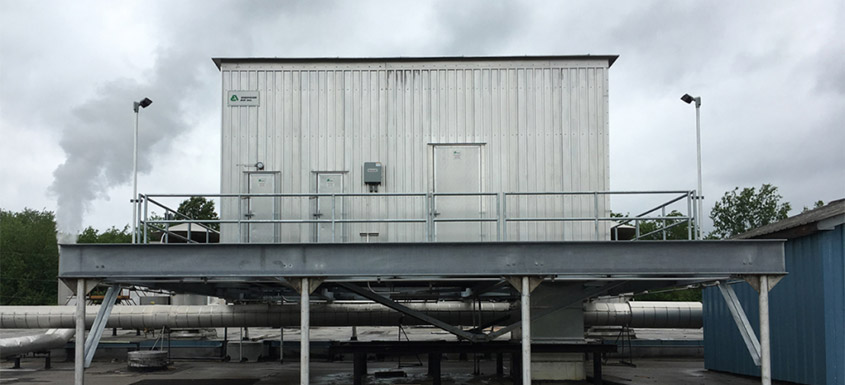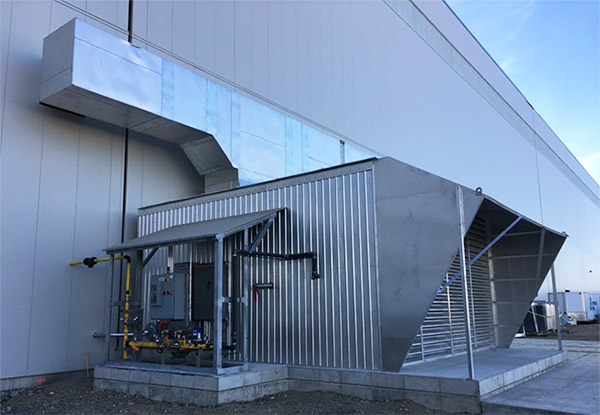Building ventilation systems that are poorly designed or lack the required capacity will often result in corrosion of the building structure and equipment, potentially unsafe working conditions and a negative impact on production. Let’s review building ventilation solutions for today’s paper mills.
Impact 1 – Corrosion
Building balance = lbs. dry air/min. (Supply) / lbs. dry air/min. (Exhaust)
- Supply air is defined as outdoor make-up air that is filtered, heated and supplied to the paper machine building by a powered fan
- Exhaust air is any air that is exhausted from the building or the paper machine hood by a powered fan.
If the building balance is less than 100%, the building is said to be “under a negative” and it will tend to naturally balance itself by outdoor air filtration. When outdoor infiltration air comes to contact with hot, humid indoor machine room air, the temperature of the resulting mixed air mass can drop to the dew point, depending on the ambient temperature. It is for this reason that condensation problems are more prevalent at the wet end of the machine room where higher humidity levels occur.
Impact 2 – Safety
- Condensation due to low building balance can create slippery surfaces which pose a safety risk to operators.
- The humidity and water near the forming area can lead to fog and/or raining in that region which leads to negatively impacted visibility.
- It is not uncommon for buildings under such a high negative that exterior doors become difficult to open leading to potential injury as they close rapidly.
Impact 3 – Production
- Condensation in the wet end may lead to water droplets falling onto the sheet causing quality issues.
- Uncontrolled air currents from infiltrated air can also cause quality issues when coming into contact with the sheet.
Six Steps Towards a Sound Building Ventilation Strategy
Step 1: Determine and set the total required process exhaust capacity from the paper machine former, press and hood. Insufficient hood exhaust results in excess hood humidity levels leading to production problems and degradation of its structure. Excess hood exhaust capacity requires additional hood make-up air to properly balance it. This added hood make-up air increases overall operating costs.
Step 2: Determine the exhaust at the wet end of the machine room that is required to achieve the desired air change rate and hence proper exhaust of the moisture load. An added benefit of additional wet end air changes is the creation of a natural sweep of air from the dry end to the wet end.
Step 3: Assess the need for roof exhausters to provide desired room air change rate.
Step 4: Determine the required fresh air supply mass to obtain desired building air balance. Industrial-grade air make-up units (image 1) must be used for long-term reliability.
Step 5: Install a wet end false ceiling. The role of the false ceiling is to provide a physical barrier that prevents the mist that rises from the former and press from reaching the roof structure. This protects the building structure and helps to confine mist. The false ceiling shall be installed:
- Above the former and press area
- From the headbox to the dryer section hood
- From PM tending side to rear curtain extending from the mezzanine to roof
Step 6: Identify heat recovery potentials to provide free or low-cost heating (PM exhaust, turbo blower, flue gas stack, etc).
Conclusions
Most paper machine building ventilation systems are deficient to some extent and mills normally lack the expertise and test equipment to properly assess the situation. Building ventilation audits will provide a list of maintenance and upgrade projects required to resolve such problems. It is rare for paper mills to have the requisite capital funds available to tackle all issues in a single project. Audit engineers will therefore work closely with the mill to plan a multi-phase project to gradually bring the system closer to industry standards and provide a safe and reliable work environment.
A comprehensive machine room survey is a powerful tool for evaluating existing building ventilation systems. After thorough testing and inspecting of all air systems, our experts will provide recommendations for improving room air conditions based on a detailed maintenance plan and a phased upgrade plan that meets the client’s budget. Contact Enerquin now for expert assistance.
Source: Enerquin














